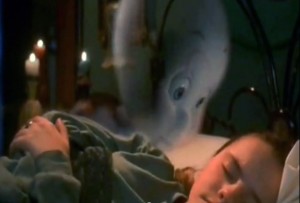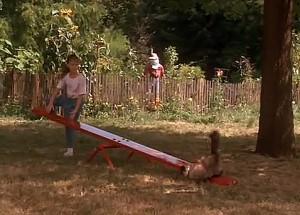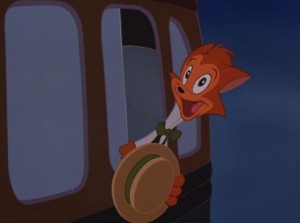Archive for category Childhood Revisited
CHILDHOOD REVISITED: CASPER
Posted by kjohnson1585 in Childhood Revisited, Comics, Film, Television, Uncategorized, Writing on April 4, 2011
Casper – (1995)
Director: Brad Silberling
Starring: Bill Pullman, Christina Ricci, Malachi Pearson
Screenplay by: Sherri Stoner, Deanna Oliver
Cartoonists Seymour Reit and Joe Oriolo created a phantasmagorical little boy in the 1930s named Casper, a friendly ghost who refuses to eschew the rules of the metaphysical, opting to try and befriend the mortal instead of haunting or scaring them. First as a children’s book and then as an animated cartoon, Casper’s foibles center around his attempts to communicate with people who consistently, automatically freak out and run for the hills. It’s a simple enough premise, mixing the whimsy of idealized Halloween with the creepy comradeship that the macabre can bring, all presentable for the young. And it worked; cartoons of the youthful spirit were created well into the 60s; even today, there are a ton of direct-to-DVD and simple cartoons out there. All of which were more or less spring-boarded by the 1995 film. Hope the re-watch won’t be horrifying! Etc.
NOSTALGIC LENS: I was quite effected by the film when I originally watched it, and I remembered it being surprisingly dark. It’s a difficult line to walk, trying to make a film about death and “what happens next” for kids, who certainly don’t do too much thinking about it. Still, I remember it being fun and chilling, impressed by the ghost effects, and quite enamored by the story. Boy, was I in for a trick-or-treat! Okay, I’ll stop.
DOES IT HOLD UP: When I re-watched this, my immediate first thought was, “This HAS to have been written by two writers.” Sure enough, two names appeared under the Written By credit, and it makes sense. It’s was like watching 2 separate movies in one, barely connected by a thread. One wanted to write a goofy kids film about a young specter wanting to meet a real girl and go to a school dance. The other wanted to write a dark tale of a loss, control, obsession, and shades of abuse. Instead of trying to fuse these ideas together, they just mixed and matched sections of each screenplay and plopped out a finished product. Scenes are starkly black and white in tone, instead of the smooth gray it should be.
Widower doctor (Bill Pullman) and his daughter (Christina Ricci) constantly move from place to place as the former seeks to “communicate” to his deceased wife, and the latter rolls her eyes, or something. Meanwhile, lonely ghost Casper tries desperately to befriend anyone brave enough to enter his haunted mansion, only to be scared off by his triple ghostly companions (or more accurately, owners) of Stretch, Stinky, and Fatso. MEANWHILE STILL, Cathy Moriarty and Eric Idle are two typical corporate-types who want to destroy the mansion for generic money-making scheme #8, but end up discovering a secret within the house, so they switch to generic money-making scheme #14.
Sounds messy, right? It is, but not overly so. It’s more or less three ideas told in five-to-seven minute chunks, and the ideas themselves are simple enough so it’s easy to follow. Also, the direction and editing is clean and straight-forward. Nothing special, nothing exciting, but just passable enough so as to not call anything into question – if you’re a kid.
Older viewers, however will call shenanigans on the parts that seem especially off-putting or nonsensical. For example, an early sequence has Pullman fighting the goofy ghosts with a plunger and vacuum cleaner. Funny, silly kids’ stuff, right? Well, after trapping the ghosts in the vacuum, the following scenes act as if THAT NEVER HAPPEN. Stretch, Stinky, and Fatso are suddenly freed and out and about – without any indication on how or why they were released. The idea, that Pullman is trying to talk these ghosts into “moving on,” is never exactly relayed to the trio of spooks. We’re supposed to assume this.
Balancing the dark with the goofy is never easy, but in Casper, the “dark” borders on horrifying territory. Watching Casper being physically abused by Stretch, Stinky, and Fatso comes off disturbing, not cute. A scene where those three basically ridicule Pullman’s dead wife is starkly cold. The worst thing, though, comes from the film’s attempt to utilize a piece of dialogue that works in the thematic sense throughout the film. The line? “Can I keep you?”
My “rival” is dead correct – that line is just fucking creepy. It doesn’t even really make sense. Part of me thinks its a child’s mistaken approach at romantic terminology (he sees it like one sees a pet or a toy), but the line directed at a young Ricci by a DEAD thing makes it come off much more terrifying.
There are some really nice moments, though. Casper recounting how he died is pretty heartfelt, an interesting approach to something that probably didn’t matter to the original run. And these final scenes are surprisingly dramatic: live-Casper and Ricci’s dance is cheesy good in the 90s sense, but Pullman’s revisit by his wife is actually quite powerful:
Beyond that though, there’s a lot of random moments, including the stuff with Moriarty and Idle, which doesn’t serve too much purpose, and is resolved in a silly way (there’s actually a weird moment where Casper and Ricci run from the ghost version of Moriarty, only to come back. Inexplicable.) Casper’s dual-narrative doesn’t exactly fuse together all that well, but it has moments of liveliness to combat the incomprehensible dread.
Oh, and Dan Aykroyd makes an early appearance as a Ghostbuster. That was kinda cool.
NEXT UP: Heavyweights
CHILDHOOD REVISITED – HOMEWARD BOUND: THE INCREDIBLE JOURNEY
Posted by kjohnson1585 in Childhood Revisited, Film, Uncategorized, Writing on January 19, 2011
Homeward Bound: The Incredible Journey – (1993)
Director: Duwayne Dunham
Starring: Michael J. Fox, Sally Field, Don Ameche
Screenplay by: Caroline Thompson, Linda Woolverton
I profusely apologize for the late posting of this entry. It was supposed to be uploaded a week ago, but last minute events held me up in preparing for my trip out to LA. To wit: it’s not that I didn’t want to continue this feature, it’s simply that the webtoon pitch and work has kept me overall very busy. That, and the fact that Homeward Bound is incredibly boring.
NOSTALGIC LENS: Homeward Bound is one of those “kill time in school” films – you know, the ones where the teacher shows it to you at the end of the day when classes are over and you’ve learned everything you could for the day, which manages to produce a short, safe, kids-friendly, 90-minute tale that does the bare minimum to warm the heart. (There are a few films that fit this list which I’ll be rewatching) While I remember mildly enjoying this film, I can’t say it particularly warmed my heart or left any lasting impression. I thought they fought a bear in this movie.
DOES IT HOLD UP: They don’t fight a bear. They fight a cougar. And they don’t really fight the cougar, because it’s painfully obvious that the cougar and the canines are in completely different spaces. It’s an editing trick. See, cause what you do is cut different frames of differently shot scenes, so it makes it seem like they’re in the same space. Movie magic!
Homeward Bound is a fucking slog. It’s a film that exist simply to exist. It certainly doesn’t have the heartwarming eye for detail and endearing elements like Babe, and yet, doesn’t inspire anger and hatred like the horrible Theodore Rex. It’s just a boring, run-of-the-mill glacier of a film, with predictable beats and nonsensical moments, and forced conflicts to make what should have been a 22-minute episode of a PBS show into a full-length feature.
Due to a huge and “incredible” eye-rolling predicament, the pets of the Seaver family – one Chase, Shadow, and Sassy – believe themselves to be abandoned at some farm when they’re placed there for a week for some reason or another. They manage to break out of their pen and find themselves trucking across through the wilderness to find their way home.
The only thing about the film that’s kind of interesting is the decision to make the pets unable to understand their human owners. This language barrier lays a somewhat plausible base in which all this could happen. But the “comedy of errors” set of coincidences that keep this film moving is so ridiculous that it drives you crazy. A local farmer misinterprets a note that the animals are fine. Chase goes nuts when some doctors help him, prompting an extra forty minutes of movie when they “escape” the very help they seek to find. There’s a random scene where a disheveled Sassy is nursed back to help, only to never be referenced again. And so on.
The writing’s filler. The acting is between bland and awful (I’m looking at you, kids). The cinematography of some of the outdoor scenes are nice, but hardly anything special. A competent cinematographer SHOULD be able to film visually striking outdoor shots. And, as alluded above, the editing is atrocious. Here’s every single complaint, in one deliciously full ten minute clip:
Beyond that, though, there’s nothing else about this film worth talking about. It certainly won’t wow or impress adults, and it barely passes the mark for “talking animal” films. Keith Phipps over at the AVClub wrote quite on point about how dogs make bad actors. The more you think about it, the more you realize that these trained creatures are really simply reacting to cues off-screen, and only the top notch editors, voice artists, and directors can really pull it off. Homeward Bound, by merely being adequate, ultimately fails.
IN A NUTSHELL: Yawnfest. Homeward Bound is as boring as the actors clearly are. I know teachers are killing time, but Jesus, you’re also killing excitement.
NEXT UP: Casper
CHILDHOOD REVISITED – CATS DON’T DANCE
Posted by kjohnson1585 in Animation, Childhood Revisited, Film, Music, Uncategorized, Writing on August 31, 2010
Cats Don’t Dance – 1997
Director: Mark Dindal
Starring: Scott Bakula, Jasmine Guy, Natalie Cole
Screenplay by: Mark Dindal, Robert Lence, Roberts Gannaway, Cliff Ruby, others
The Netflix blurb described Cats Don’t Dance as a “nostalgic animated version of classic MGM musicals.” That got me pretty stoked. As a youngin’, I had failed to make that connection since, while I was aware of the existence of musicals, I didn’t quite grasp their impact and significance in the overall development of American cinema and stardom. Also, watching a non-Disney animated film is always a treat, since you get to experience different themes, ideas, and movements. And, let’s be honest: Disney wouldn’t have released a film like this with such a lame title. Cats Don’t Dance? Really? The furry version of White Men Can’t Jump? Not exactly the warmest sounding title around.
NOSTALGIC LENS: I remember going to see this film by myself. It looked like a fun and eccentric romp through some crazy sets, and it was. Just TOO eccentric. Everything was going so fast and moving in blurs, harsh cuts, and speedy camera tricks that I had no idea what was going on. I remember none of the songs or secondary characters, save for the big-ass butler and really, really stupid ending sequence that actually irritated me, even in terms of cartoon logic. I’ll save that complaint – if it still holds – for the write-up.
DOES IT HOLD UP: I’ll say this: Cats Don’t Dance was not intended for the big screen. It’s a film tailor-made for the small screen – for closer observation. How often do you hear that?
Cats was marketed as a simplistic kids film of colors and frantic movement, talking animals and an Animaniacs-like exaggeration of animation, which simply put, means it’ll keep kids quiet for an hour. The movie, however, is a brightly-rainbow’d homage to not only the MGM classic musical, but the original musical nature of the early black & white/Merrie Melodies era of sing-songy cartoons. It’s a historical piece – a pretty goddamn esoteric one, but the signs are all over the celluloid.
Of course, young kids wouldn’t get it. Of course, parents wouldn’t understand what the film was delineating. The only people that may have been aware of the film’s aesthetic ties may have been historical animation fans, but that requires a clear and free understanding and appreciation of the history of American animation (and film) of a specific time period of a specific genre. That’s a rather egregious disconnect. In that way, Cats Don’t Dance is a failure, since it does little to draw its audience in and clarify its intent.
However, if you ARE aware of all of this, Cats Don’t Dance is a fresh, glorious treat of frantic action, a ballsy film against the slow, straight-forwardness of Disney or Pixar films. It’s tale – homely cat Danny travels to Hollywood to make it as a big time dancer and singer – is so typically cliche of one-third of the plot of most musicals, but that’s the point. Its entertainment draws from the energy of songs that break out of no where, of speedy dance numbers that develop into visual pastiches of its medium, of physical gags no longer utilized save in Spongebob. Check out the first ten minutes:
The simplicity of the opening montage segues into a much more exciting music piece. It’s like we’re going backwards; “Now Our Time Has Come” is such a 90s “hope song,” but “Danny’s Intro” is a play to exploring that new Hollywood space, a Wizard of Oz-like ballad of early triumph. Hello, 50s.
As I mentioned, Cats Don’t Dance homages the animated musical shorts as well. Remember when animated figures would grab random objects in a junkyard or alley and make awesome impromptu music?
I can’t help but think about this notorious cartoon when thinking about this film:
(You may have heard this on a certain South Park episode. Also – my man Tex directed this classic.)
The movie is filled with moments like this, as well as surprisingly sharp jokes about the time period. Sure, some are groaners (Rats being offended by the line “I smell a rat”), but there are some nifty ones, like when antagonist Darla Dimple (an evil Shirley Temple clone) only bites off the heads of animal crackers in front of Danny. (Darla’s offer, though, excites him so much that he starts eating the crackers too. In fact, the entire sequence between Danny and Darla is a lot of fun.)
Which is why the ending disappoints. Musicals, in general, seem to have weak, “JUST WRAP IT UP” type finales that’s all style and no substance. Whether Cats Don’t Dance played to that or not still doesn’t make it any better. Danny’s fight with big brute Max is exciting (and a marvel in animated form), but the ending sequence does nothing to build on that. Darla flicks a number of switches to try and ruin Danny and company’s final number, but it just makes it more awesome. It lacks the pluckiness of Danny’s earlier battle; none of the characters ‘fight’ through the chaos to deliver a great piece. Everything just works out. Ho-hum.
But for one hour, Cats Don’t Dance is a loose, whimsical, enjoyable film, a song/dance “cartoon-cartoon,” and not simply an animated live-action film. (The last animated film to employ such a free-sense of itself? The Emperor’s New Groove.) And it’s surprisingly relevant. Darla essentially screws Danny over; sure, Danny uses his skills and abilities to bounce back and win in the end, but he too had to do some sneaky shit to even earn that right (break into the theater of Darla’s movie premiere.) As much as we’d like to think that our abilities should speak for themselves, unfortunately in this job market, we may have to get a bit dirty before starting the cleansing process.
IN A NUTSHELL: I found myself really drawn to this film, so much so that I wanted to watch it a second time almost immediately. Sure, it’s flawed, but it’s a movie that’s one of its kind; a film that aims to be more aesthetically informative and historically nostalgic. Does it work 100%? No. But it does make you pine for the days where you can sing-a, along with the moon-a and the June-a, and the spring-a. While avoiding an anvil or six.
EDIT: I should have mentioned that Gene Kelly himself worked as a consultant on the film before he past away, which clearly contributes to the show’s wonderful energy and dance numbers.
NEXT UP: Homeward Bound: The Incredible Journey




